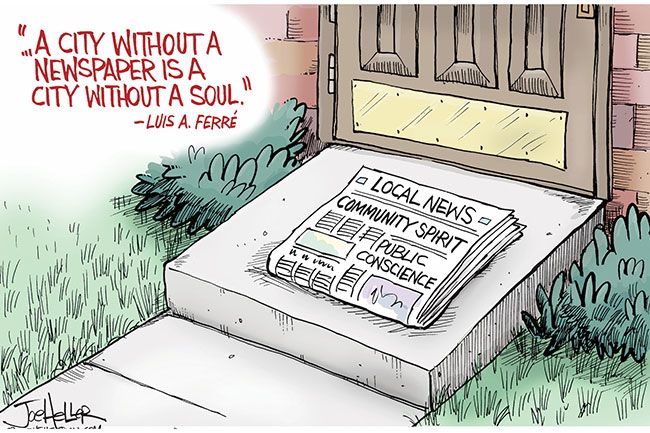Brier Dudley: News deserts grow as more local papers close


As proposals to help save local journalism gathered dust in Congress and mostly fizzled in state legislatures over the last year, 136 more newspapers closed, according to a new report.
More than half of U.S. counties are now news deserts, leaving 50 million Americans with little to no local reporting on their communities, according to the State of Local News 2025 report by Northwestern University’s Medill School of Journalism. It found 213 counties now have no local news outlet and 1,524 have only one, usually a weekly newspaper.
The periodic news desert report raised national alarm when it first documented the severity of America’s local-news crisis in 2016, when the project was based at the University of North Carolina. Although it’s not perfect, and draws barbs from some quarters, it continues to anchor conversations among policymakers, industry leaders, advocates and others working to save local journalism.
The report draws on 20 years of data tracing “the arc of historic change that we’re all living through in the local media industry,” Tim Franklin, Medill’s local news chair, said during its rollout last week. “As I wrote in my introduction for this year’s report, this really is the culmination of wrenching retraction, inspirational creation and unceasing transformation,” he said.
In recent years, the report has broadened to include digital-news sites, public broadcasters and other outlets, but much of it details the decline of newspapers, which continue to fail at an average of two per week. Newspapers remain “the backbone of the American media ecosystem, and are more numerous than all other media types combined,” it states.
In previous years, newspaper closures were often the result of chains consolidating and shutting papers. This year, researchers found more independent, locally owned and family-owned newspapers are closing.
“And of course, those are the very people, very owners, that you want in local news — those that have been doing it for decades, those who are committed to the community, passionate about local news and informing their communities,” Franklin said. “And many of those folks over the course of the past year have simply succumbed to the economic pressures.”
The report, led by Medill’s Zach Metzger, tallied 8,000 news outlets, including 5,428 remaining newspapers.
Since 2005, nearly 3,500 U.S. newspapers closed, a 39% decline.
Consolidation over two decades left 53% of newspapers owned by chains. Dailies are even more consolidated, with fewer than 15% now independently owned.
During that period, newspaper employment plunged 75%, from 365,460 to 91,500 through 2024, per the latest federal data.
In Washington, the report counted 98 local newspapers, down from 103 in 2024. It identified 20 digital news sites, 18 ethnic media outlets and nine public broadcasting stations.
Asotin County, in the southeast corner, is deemed a news desert with zero local outlets, although it’s covered by The Lewiston Tribune, based in Idaho.
Oregon was found to have 62 newspapers, down from 66 in 2024. Wasco, Sherman and Wheeler counties were deemed news deserts.
Wasco County’s newspaper, The Dalles Chronicle, closed in 2020 when it joined the White Salmon Enterprise in merging with the Hood River News. The combined paper, the Columbia Gorge News, is now a weekly with around 5,000 print subscribers.
“We do have an office in The Dalles, but it’s true, it’s hardly ever staffed,” publisher and owner Chelsea Marr told me.
Marr, previously publisher of The Dalles and Hood River papers, acquired them in 2020 — on April Fool’s Day, to be exact — from a chain planning to shut them down. She employs four full-time journalists, along with freelancers and two part-timers, to cover Wasco and other counties on both sides of the Columbia River.
To bolster local journalism and prevent further closures, the Oregon Legislature nearly passed a bill requiring Google and other tech giants profiting from news to compensate local outlets, paying a total of $122 million yearly. It failed in June, even though Google was by then a convicted monopolist, found to have harmed publishers with illegal conduct in digital advertising.
“It would have helped tremendously,” Marr said. “The business is very up and down. You just hope that you’re going to end up in a positive. There’s some months you don’t.”
Medill’s report identified 685 online-only news outlets nationally, a gain of 23 over the last year. That included startups and newspapers that quit printing to become online only, like The Star-Ledger in New Jersey.
Also counted this year were 54 “network digital sites,” a term that includes online chains and aggregators like Axios and Patch, which operate 849 local sites.
The report examined philanthropy supporting local journalism.
A variety of outlets received grants, the report found. But its review of the 10,000 largest journalism grants over the last five years found 98% of the dollars went to organizations in urban areas, even though news deserts are mostly in suburban and rural areas.
“It’s really leaving the small, rural operations at the highest risk,” said Heidi Wright, a former publisher now serving as president of the nonprofit Fund for Oregon Rural Journalism.
It’s not entirely bleak.
The report highlights “bright spots,” including a dozen successful local outlets. Among them are the online outlet BikePortland, The Houston Chronicle newspaper and Lookout Local online outlets in Eugene, Oregon, and Santa Cruz, California.
But the coming year will stress the entire industry. It could make next year’s report a doozy.
Inflation is pushing operating costs higher. That’s happening as web traffic, which outlets need to grow revenue, is being siphoned off by AI platforms
The report noted web traffic to the largest 100 newspapers fell more than 45% in the last four years.
“It is a challenging time,” said Dean Ridings, CEO of the America’s Newspapers trade group, “and it may get worse, absolutely.”
I must disclose that I recently worked with Medill’s Local News Initiative on a story about outlets finding ways to survive and remain independent.
I wasn’t involved in producing the report, only the story drawing on its findings. It will appear in a few weeks.









Comments